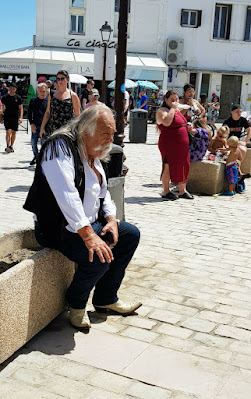The Rhone delta is called the Camargue, a huge area of marshland and water channels. It is an hour by car from St Remy. As with the fenland in East Anglia, a large part has been adapted for agricultural use and also to reduce mosquitos, but I assure you that there are still plenty left! The photo is of a typical crop, one that wouldn’t be possible in the fens – rice. The water levels are controlled by the dyke on the right.
There are still plenty of original wetlands remaining, mostly the sections nearer the sea, where exotic species like flamingos are to be found.
The Camargue is
also famous for its wild white horses, but it’s debatable as to how many are
really wild. The numerous horse trekking centres here all use white horses that
are have clearly been tamed, but let’s pretend that the herd in the next photo
are the real thing.
This is where black fighting bulls are bred to be used in
bullfights in this part of Provence. The spectacle takes place in such historic
places as the Roman arena at Arles. Unlike Spanish bullfighting, the bull is
not killed and the bullfight amounts to a contest between the agility of the
matador and the bull. Here they are looking deceptively docile.
There is just one town in the Camargue, on the Mediterranean, Les-Saintes-Maries-de-la-Mer. It is named after St Mary Jacobe and St. Mary Salome. One of the Marys (no agreement on which one) had a daughter Sara who is the patron saint of gypsies. At the end of May each year thousands of gypsies travel here from all parts of Europe to celebrate their Saint Sara in a week-long festival.
By chance, we happened to visit the town on the Saturday of the festival week. We managed to park with great difficulty as the town was thronged by thousands of gypsies with their caravans, and multitudes of sightseers like ourselves.
The festival is focused on the church where the effigy of Sara lies. The church was fortified to provide protection for the residents in case of attack by pirates. We’re not too sure that the pirates have gone away.
Sara’s effigy is taken from the church towards the sea in a
slow procession several times during the week, but unfortunately not when we
were there. Sara must be kept somewhere near the altar end in the photo but I thought
it best not go for a close-up.
Most of the gypsy caravans were modern but there were a few
traditional ones that must be stored locally: can’t imagine this one trundling
all the way from, say, Romania!
We saw off-the-cuff gypsy guitar music and dancing, very much like flamenco.
Some gypsies had dressed up for the occasion, as in the two
following photos. The lady looks very elegant but the man seems to be stuck in
the 1960’s – look at those winkle pickers, no wonder he’s sitting down!.
We managed to bat off the charmless charm sellers which was only
a minor irritation in a pleasant and unique day out. The town itself, because
of its isolation, has its own identity and even its own cross which is a
crucifix with an anchor. This symbol appears everywhere, for example even on this
(decaying) front gate.











